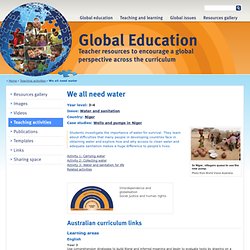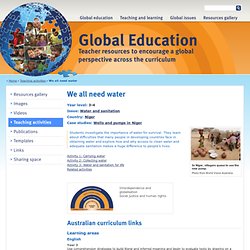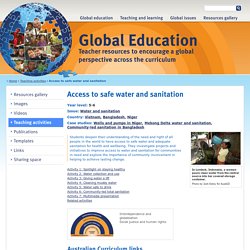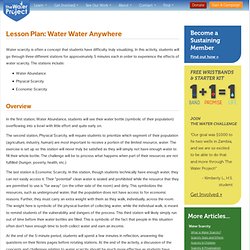

We all need water. Learning areas English Year 3 Use comprehension strategies to build literal and inferred meaning and begin to evaluate texts by drawing on a growing knowledge of context, text structures and language features (ACELY1680) Year 4 Interpret ideas and information in spoken texts and listen for key points in order to carry out tasks and use information to share and extend ideas and information (ACELY1687) Mathematics Use simple scales, legends and directions to interpret information contained in basic maps (ACMMG090) General capabilities LiteracyCritical and creative thinkingPersonal and social capabilityEthical behaviorIntercultural understanding Cross-curriculum priorities Sustainability Students explore a variety of ways that water is collected where there is no infrastructure to deliver it to people’s homes.

Preparation 1 litre containerbucket. Brainstorm a list of the ways you and your family use water. Draw a diagram showing how water gets to you. Examine a one-litre container. Discuss: Human rights. We all need water. Learning areas English Year 3 Use comprehension strategies to build literal and inferred meaning and begin to evaluate texts by drawing on a growing knowledge of context, text structures and language features (ACELY1680) Year 4 Interpret ideas and information in spoken texts and listen for key points in order to carry out tasks and use information to share and extend ideas and information (ACELY1687) Mathematics Use simple scales, legends and directions to interpret information contained in basic maps (ACMMG090) General capabilities LiteracyCritical and creative thinkingPersonal and social capabilityEthical behaviorIntercultural understanding Cross-curriculum priorities Sustainability Students explore a variety of ways that water is collected where there is no infrastructure to deliver it to people’s homes.

Preparation 1 litre containerbucket. Brainstorm a list of the ways you and your family use water. Draw a diagram showing how water gets to you. Examine a one-litre container. Discuss: Human rights. Access to safe water and sanitation. Learning areas English Year 5 Identify aspects of literary texts that convey details or information about particular social, cultural and historical contexts (ACELT1608) Plan, rehearse and deliver presentations for defined audiences and purposes incorporating accurate and sequenced content and multimodal elements (ACELY1700) Year 6 Make connections between students’ own experiences and those of characters and events represented in texts drawn from different historical, social and cultural contexts (ACELT1613) Participate in and contribute to discussions, clarifying and interrogating ideas, developing and supporting arguments, sharing and evaluating information, experiences and opinions (ACELY1709) Mathematics Choose appropriate units of measurement for length, area, volume, capacity and mass (ACMMG108) Connect volume and capacity and their units of measurement (ACMMG138) Science General capabilities Cross-curriculum priorities Sustainability Compare lists and discuss.

Discuss the following questions: Lesson Plan - Water, Water Anywhere. Lesson Plan: Water Water Anywhere Water scarcity is often a concept that students have difficulty truly visualizing.

In this activity, students will go through three different stations for approximately 5 minutes each in order to experience the effects of water scarcity. The stations include: Water Abundance Physical Scarcity Economic Scarcity Overview In the first station, Water Abundance, students will see their water bottle (symbolic of their population) overflowing into a bowl with little effort and quite early on. The second station, Physical Scarcity, will require students to prioritize which segment of their population (agriculture, industry, human) are most important to receive a portion of the limited resource, water. The last station is Economic Scarcity. At the end of the 5-minute period, students will spend a few minutes in reflection, answering the questions on their Notes pages before rotating stations. Materials Procedure: 1. 2. 3. 4. STATION 1: Water Abundance 5. 6. 7. 8. 9. Water Use Around the World.
Students compare their water use with water use in other places around the world.

Printable work sheet included. The availability of clean water is something that most of our students take for granted. This lesson will explore the availability of clean water throughout the world. On each card write the name of a country and the number of gallons of water each person in that country uses each day. (If you teach students in grades 5 or below, you might round off the numbers; for example, round off 5.8 gallons per day to 6 gallons a day.)